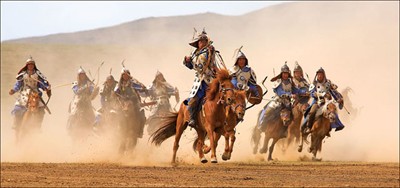Rick Sammon Interview: Famed Photographer Travels the Globe in Search of the Perfect Shot
Written by Melissa Parker, Posted in Interviews Photographers
When asked about his specialty, famed travel photographer Rick Sammon answers, “My specialty is not specializing.” He is, however, considered one of today’s top digital-imaging experts and has been nominated for the Photoshop Hall of Fame.
Sammon has published 36 books including Secrets of HDR Photography, Exploring the Light, and Digital Photography Secrets, but he is also a leader in iPad and iPhone photography apps which include Rick Sammon’s Light It!, Rick Sammon’s HDR Portfolio, and Rick Sammon’s 24/7 Photo Buffet.
"Some people think they have cannibals in New Guinea. All of the people in that photo who look like cannibals all work for the oil companies over there and they get dressed up for the tourists."
The New York native co-founded the Digital Photography Experience podcast, hosted many episodes of Canon Photo Safari on ESPN, has photographed in 100 countries, and gives more than two dozen photography workshops and presentations around the world each year.
Melissa Parker (Smashing Interviews Magazine): Rick, where are you living now?
Rick Sammon: I grew up in Long Island. I’m in upstate New York now at Croton-on-Hudson.
Melissa Parker (Smashing Interviews Magazine): I read that you attended Catholic school.
Rick Sammon: (laughs) Thanks for reminding me, yes.
Melissa Parker (Smashing Interviews Magazine): Surely you have some interesting stories to tell.
Rick Sammon: Well I do. There was this nun who used to hit our hands with the rulers so she wasn’t my favorite person, but the first wake I ever got to go to was hers in the convent. Her name was Sister Lucia. But, I guess I learned something because I’m doing okay.

Rick Sammon (on bottom) falling through the air at 125 MPH (Courtesy of Rick Sammon)
Melissa Parker (Smashing Interviews Magazine): The obvious question is, of course, why did you get interested in photography?
Rick Sammon: My father was always into photography so I took a lot of pictures, but I actually went to Berklee College of Music. I loved and still love music. When I got out I started teaching. I had plenty of down time because I didn’t teach until the kids came out of school so I took pictures. I sent one to a magazine on a whim and it got published. They asked me to write an article and it was also published.
Two years later, believe it or not, they asked me to be the editor of the magazine. I did that for three years and was still taking pictures. Three years after that Minolta’s advertising agency called and they said, “Would you like to have the Minolta Public Relations account?” I guess they liked my style. So from 1980 until 1990 I was the Vice President Supervisor of Minolta Accounts.
You know, I went to Woodstock in 1969 and the whole feeling back then was to be free and love what you were doing. So in 1990, when I was 40, I left the agency and decided I wanted to be a travel photographer. What really helped me out was Wayne Dyer’s book Real Magic. In the book he says if you start living the life you want to live then that becomes your life. Even while at the agency I would get dressed up like a travel photographer, go to Africa on my vacation, and play photographer. When I left the agency it evolved into what I’m doing now.
Melissa Parker (Smashing Interviews Magazine): Do you always keep a camera in the car wherever you go?
Rick Sammon: Well I do always try to have a camera with me even if it’s the iPhone camera, but I find that if I go to really cool places I get inspired. It’s nice going out by myself, but I also love teaching. I bring my camera to many of the workshops. If I go to Alaska, for example, to photograph bald eagles, I bring a bunch of people with me and we have lots of fun.
Melissa Parker (Smashing Interviews Magazine): On your Facebook page you ask, “What is the most important thing about a photograph?”
Rick Sammon: Yes.
Melissa Parker (Smashing Interviews Magazine): I would think that the most important thing would be that the photo tells a story. What is your opinion?
Rick Sammon: Many people get bogged down in the technical aspects like the right exposure, right focus, and all of that other stuff, but the whole thing is the feeling and the mood of the photograph.
I posted a photo of one of my friends in a cowboy hat in a tack room. It’s a personality portrait. So I think it’s really capturing the mood and the feeling of the situation with the subject’s personality. There’s something about an out of focus picture. One out of focus picture is a mistake. Twenty out of focus pictures is a style.
About twenty years ago I was at the Metropolitan Museum of Art and there’s a picture hanging on the wall of a roll of toilet tissue. It’s out of focus and grainy and the name of it is Loo Paper. All of this stuff is just so subjective.
Melissa Parker (Smashing Interviews Magazine): You have written 36 books.
Rick Sammon: I have, but lately I’ve gotten into apps. For photographers, especially with the iPad, apps are really where it’s at. One of my books cost $30 in the United States and may cost $60 in Australia or England whereas an app with most of the information might cost $5.00. There are no production costs and it’s better for the environment and that’s all good.
Melissa Parker (Smashing Interviews Magazine): Your latest book subject is HDR (High Dynamic Range Imaging).

Elegant Woman: A portrait taken during Carnival in Venice, Italy (Photo by Rick Sammon)
Rick Sammon: And since then I have an app called iHDR. You know, we’re all in this mobile community now with iPhones and iPads so that’s really where I’m going.
Melissa Parker (Smashing Interviews Magazine): So there’s an app that teaches HDR on the iPad?
Rick Sammon: Yes. My apps don’t do anything. They are teaching/educational apps. I have six children’s books and my latest app is a children’s app called Underwater Wonders.
Melissa Parker (Smashing Interviews Magazine): A photographer can certainly be creative with HDR.
Rick Sammon: Oh yeah. People say, “Oh HDR is a fad.” I tell them that Ansel Adams, the most famous landscape photographer ever, did HDR back in the wet darkroom in the 60s using different chemicals and papers, exposure times, and so forth. He didn’t call it HDR but he tried to make the same look as it looks to our eyes where we could see deep into the shadows and the highlights would not be washed out. That’s what his photos were known for and that’s what we can do with HDR.
Melissa Parker (Smashing Interviews Magazine): Let’s talk for a few minutes about your travels. A hundred countries?
Rick Sammon: Yes.
Melissa Parker (Smashing Interviews Magazine): And you were sick in only two of them?
Rick Sammon: Only got sick in two of them, but Marco Polo had a great expression and it was, “An adventure is misery and discomfort relived in the safety of reminiscence.” That means you can be sicker than a dog like I was in Antarctica, but it was still a great experience. I was on a ship and out of 80 people 40 had this Norwalk virus which is one of the most violent viruses known to man. It’s pretty bad. I thought I was going to die. They locked us in our cabins because they didn’t want it to spread. We were in Antarctica for six days, so not counting the travel days I was only out of the boat one day.
Melissa Parker (Smashing Interviews Magazine): Do you have a favorite place to shoot, Rick?
Rick Sammon: Laos. I say that quickly because it’s a recent place I’ve been. I love that part of the world. I love Cambodia, Thailand, Nepal, India, and Bhutan is beautiful. But there was something special about Laos. The people are nice and friendly and the country is beautiful. I love the temples and the culture.
I’ve been traveling around now for 24 years and I would say in the last 5 years I’ve explored the United States more than ever. You go out west to Arches National Park. Places like that are awe inspiring so you don’t have to go to Laos to get inspired.
Melissa Parker (Smashing Interviews Magazine): You have a photo on your website with the caption, “Rick in Papua New Guinea shortly after his rescue.”
Rick Sammon: That was a joke (laughs). Some people think they have cannibals in New Guinea. All of the people in that photo who look like cannibals all work for the oil companies over there and they get dressed up for the tourists.
Melissa Parker (Smashing Interviews Magazine): (laughs) Funny. Rick, how many cameras do you normally take with you to other countries on a shoot?
Rick Sammon: Not only do I not take a lot of cameras, lenses, and accessories, I don’t shoot a lot of pictures. I know many people take tons of stuff and then they get bogged down trying to find the right lens or whatever. I travel light. I take two cameras and really one is a backup. I take a wide angle lens or two and a telephoto lens or two. I don’t shoot a lot because in life it’s very important to set goals. If you set a goal you’re going to get there. In photography, I tell people that it’s very important to set goals too.
Getting back to Alaska, one morning the only type of picture I wanted was to get a nice reflection of a bald eagle coming in to take a fish out of the water so I’m focused on that shot. A million other pictures were taken that day by other photographers of birds flying in the air by the water with the busy background doing this or doing that but I set the goal and I got the shot.

Ride On: Mongolian soldiers photographed during a festival in Mongolia (Photo by Rick Sammon)
Say you’re going to the Bronx Zoo and you want to get a picture of a polar bear doing something. Don’t take a million pictures of the polar bear. Set the goal. If you want to get a picture of him yawning, set the goal. If you do that you’ll get a higher percentage of pictures that you like.
Melissa Parker (Smashing Interviews Magazine): Is there an “everyday” camera that you prefer?
Rick Sammon: Well I have a little Canon G11 which is a point and shoot camera. There’s an old expression: “Cameras don’t take pictures, people do.” I have a book called Confessions of a Compact Camera Shooter. I confess that I actually do use this little camera that costs under $500 in addition to my other stuff. Again, if you think that this is what you have to shoot with you can plan your shots and get the kind of pictures you like.
Melissa Parker (Smashing Interviews Magazine): Is the Canon G11 what you would recommend for a beginner or for someone who takes photos only at family reunions and birthday parties?
Rick Sammon: Yes. They actually have a new one called Canon G12. You can’t change lenses but it has a zoom lens. You can shoot on automatic or manual and it fits in your pocket if you have cargo pants. Many people get bogged down in all of this equipment which you would need if you want to go to Africa and get a close-up shot of an animal, but for everyday shooting those little point and shoot compact cameras are great.
Melissa Parker (Smashing Interviews Magazine): What type of lens do you recommend for an advanced photographer shooting fast action or sporting events?
Rick Sammon: If you’re into sports and you could only buy one lens I would recommend a 70-200 mm f/2.8 lens. The reason you want the f/2.8 is because it lets more light into the camera than say a 70-200 f/4. There’s more light but you shoot at a faster shutter speed. 70-200 is a good all around lens. The guys on the sidelines at the Super Bowl may have 600 mm or 500 mm lenses which might cost $4,000 or $5,000, but you can get a 70-200 mm lens for about $1,500.
Melissa Parker (Smashing Interviews Magazine): Do you ever apply the rule of thirds or other photography rules while shooting?
Rick Sammon: I have a bunch of rules. One is that dead center is deadly meaning don’t place the subject in the center. However, sometimes that works. Another rule is when you’re photographing a seascape don’t put the horizon line in the center of the frame. But, guess what, sometimes that works. So it’s good to know the so-called rules but it’s also good not to get locked into all of the rules. Otherwise you’re just following someone else’s rules.
Melissa Parker (Smashing Interviews Magazine): Tell me about the Canon Photo Safari series.
Rick Sammon: What we did on that series was to take celebrities around to exotic locations and I taught them how to take pictures. By looking at the show the viewers got to learn how to take pictures also. I took Dana Delany to the Galapagos which was fun. I did three shows in Africa with John O’Hurley who played John Peterman on Seinfeld. I did a couple of shows with Kelly Packard up at Lake Placid.
Melissa Parker (Smashing Interviews Magazine): You also teach photography seminars.
Rick Sammon: Actually I do a lot of workshops around the country where I take a few students to places and we all shoot. I do seminars where I might get several hundred people in a room and I give a presentation. I really do love teaching.
My mother taught me something when I was young. She said, “You never know who’s watching.” This is true. I was giving a seminar in a hotel room in Florida. At the end of the day a guy comes up and says that he’d like to take one of my workshops, but he’d like it to be a private workshop. He then tells me we can go wherever I want to go. It turned out that this guy was a zillionaire and I gave him a private workshop in Mongolia for two weeks.
When I told that story again it happened to me again. When you put stuff on Twitter and Facebook you never know who’s watching and reading. You may have a customer out there who might want to take you to Botswana or Mongolia, you never know.
Melissa Parker (Smashing Interviews Magazine): And the moral of that story is that you need to keep telling that story.
Rick Sammon: Well that’s it. That’s why I’m telling it again (laughs).
© 2011 Smashing Interviews Magazine. All rights reserved. This material may not be published, broadcast, rewritten or redistributed without the express written consent of the publisher.

